|
I have approched Matilde Sartorari's work only lately.
It was a fortuitous meeting that got me a great happiness as if her"pictorial form", that tender and at the same time powerful balance of hers between connotation and subjects, could give a perfectibility light to the incomplet and cut sediments of the most remote artistic vocation of mine.
Every picture has its "proportion"within a wise search of colours, armonies of tracts flashes lights, of vital shadow excavations.
Not a play.....rather a capable and inexhausted look subsiding on facts and never on things.
Stopping...beyond the flowers, the countries, the shapes...remaining a little bit in silent, you can feel the very light ticking of the hour, consuming itself in the happiness of her glance ...
Some critical pieces, as follows, starting from 1919, allow us to revisit the cultural contest which has placed side by side Matilde Sartorari's pictorial research. And even if she sometimes has been good condidered by a criticism full of doubtfull benevolence, its influence has not been so determining....:
Infact Matilde goes on with a perfect assonance with herself: "she says and...she doesen't let her to be said".
La Poesia se explica sola; sino no, no se explica.Todo comentario a una poesia se refiere a los elementos circundantes a ella, estilo, lenguaje, sentimientos, aspiracion, pero no alla poesia misma. La poesia es una aventura hacia lo absoluto.
PEDRO SALINAS
The Matilde Sartorari's still lives, many of her sketches, landscapes, shapes, seem to be painted by a viril and very expert hand.
Some pieces are a real prodigy of colour armony.Certain little impressions are so bright, happy of light and so fresh of vivacity, that they can remember us the best things of the most glorious toscan painters of ours.
It is an art5 without artifices, without thought pretensions, but with sincerity of vision and expression, rapid and safe touches.
Under the colour there is the drawing and Sartorari can prove her ability in drawing through some little pencil sketches drawn with a great sense of globality and movement.
FERDINANDO PAOLIERI (La Nazione, giugno 1919)
Cesare Ciani...could teach his pupil only one thing: the faithful respect of the nature; only a rebel and libertarian heir of that glorious ideal patrimony could teach, in any other way could influence the delicate shaping of a new personality.
GIUSEPPE DE LOGU (Voce Repubblicana, 1923)
The confidence, freshness and naturalness of this painter with safe eye and easy hand that has assimilated a pictorial worls with the quickness that women have istinctively; all the more that She doesen't imitate ... absorbs.
ROBERTO PAPINI(Il Mondo, 1923)
If we look at better, in more than a painting, we can note immediately something clean, dry, marked,....but pretty, in short well said, that it's just the best toscan manner".
LEONARDO BORGESE (Corriere della Sera, 1950)
In her way of painting is consubstantially and at the same time present the happiness of the creative act, not the fatigue and the concentration, as is often manifest.
The datum emerges, even though irrational and unusual; the happiness transfers itself to the observer by contact.
A fact is surprising for those who know her. Matilde Sartorari, living alone, in humble discretion had problem, troubles, solitude. The observers of her paintings asks themselves incredulously how the artist nevertheless that could make flow spontaneity, preserve serenity, keep the bright glance of youth.
Here is a woman in which the innocence has not died. And she is not seventeen years old anymore.
GILBERTO ALTICHIERI (from Exhibition Catalogue: Matilde Sartorari, San Floriano, 1974)
Extracts from: Una ricerca libera e appartata
G.L.VERZELLESI
"Introduzione alla Mostra Antologica, Dipinti e Disegni 1919-1984"
MATILDE SARTORARI - Sessant'anni di Pittura
GALLERIA DELLO SCUDO - 1985 - Verona
To appreciate the quality of Matilde Sartorari figuration, we need to exit form the circle of snob modernist, that has eyes only for the last art and - following the sharp but unexceptionable expression of Huizinga - "lives in the short-sightedness of the moment".
To pick up the genuineness of the talent, that the veronese painter was able to keep alive also during the last decades, we need to bandon false storicism that continues to create problems about tendencies and that disqualifies as "old" everyhing that is not enough rich of provocatory novalties ...
... from this convinction derives a quiet, very strong refusal to share the different poetic experiences of the 20th century that have the purpouse of theorizing, as a programmatic and inevitable need, the taste of trasgression, dissonance, "deprivation" of art to which "the tone of misfortune"would be prescribed by an inevitable mark of authenticity.
But this Sartorari's refusal (that caused her isolation and that explains, even if it doesen't justify, the inattention of certain critics, that consider only the more noisy shakes of the avant-garde tendencies) is a mark of fidelity to a life and art conception that has nothing in common with modernism, in which "antitraditionalist energy becomes a whirl that swallows everything .... (Adorno)"
... Every art - as Tolstoj noted in his journal - can deviate from the main street in two ways: volgarity and artificiality. Between these two wrong ways there is only a small narrow street.
And Sartorari has continued to go on without looking around herself along this small street, without fear of remaining alone or too far from avant-garde path, as described "taste oscillation" of vogue. She has been able to oppose a quiet refusal to the needs of conformist updating, to the ambition of arriving and emerging (following the example of the very few "snob of genius" and of the more and more numerous snobs without talent), a refusal that does honour to her, not because of a blind conservatorism, with the purpose of reducing art to an ambalming process or gelid ricopy of certain figurations at present old and stale: but just for the invincible tenax by which the painter, without entering the modernistic snobism and without being antimodern, has continued to test her talent going along "small street" indicated to her by Ciani many years ago: a very human teacher that, with inflexible probity, continued to repeat to his pupil words not so different from those (famous but now almost forgetten) saying: "we have to cultivate our garden without losing ourselves in the undergrowth of vanities and without being distracted by the contents that can destroy inspiration.
We have to continue to draw and paint trusting our eyes, that can search and pick also among the poorest appearances, a throb of truth: a grane of life to be risen in the works.
Matilde Sartorari, something fresh.
Wondering why Matilde Sartorari's Work doesn't appear among the institutional pages of art history of 20th century provokes a reflection by now banal and old: female creativity has never met during the centuries a favour similar to that reserved to male geniality.
When Artemisia Gentileschi, artist of safe talent, has been resuscitated thanks to feminist thought, at the end of the seventies, that's to say after 400 years, from the ice coffin that has compelled to hundreds of generations to come in touch with the wonders of her titanic innovating force, also a refined critic like Robero Longhi didn't exitate to quote her like "the only woman of art history that had understood something of painting"…Here it is that while a monstruous historic wrong was amended, another one, similarly monstruous, was opened towards "one thousand artist women" bound…strictly to a rank…without citizenship.
Matilde Sartorari entered in this consolidated historical climate when she was very young.
Critics called immediately te wonder at the first appearance of the sixty "macchiaiole impressions" in the rooms of "Lyceum" in Florence in July 1919.
She was only seventeen when she astonished the "ornate dame" of Lyceum mortifying the waiting for a romantic giuliet.
Almost self-educated to art sensibility, Matilde already wonderfully drawed and not for literal care of detail but for an extraordinary intuition that allowed her to show with impressionistic manner, thanks to precious formal and colouristic syntesis, the inexausted awesomeness of the surrounding natural world.
The art critic Mario Tinti, of "Il Nuovo della Sera", reacted a little bit heavily to her sudden and informal entry into the panorama of italian art, dedicating her incomparable article for the density of prejudicial observations:
Although I knew that not all women painters are "ladies and young ladies that paint", anyway it had happened to me not so often to have to admit into the rule of dilettantism and of superficiality of womanish painting so a clear exception as in front of the paints and the draws that the Young lady Matilde Sartorari - a painter not yet eighteen - exibithed in a room of Lyceum.
After having praised the qualities of spontaneity, istintivity, immediate perception of the colour and form, of the young painter and after having assigned her a good "colour tasting", here's the conclusion:
The young lady Sartorari, who was pupil of Francesco Gioli and now studies with Cesare Ciani, similated, expecially from the first of these two excellent teachers, not only the colour accent, but also some formal characteristics, and she has similated with so a great adherence to provoke in someone the doubt that her qualities are the consequence of exceptional mimetic and imitative faculties more than expression of individualities.
This is the doubt that every disciple must try to destroy his own convinction and that of the others.
And I see something fresh , candid, native in the first tests of this young, outside of the teachers suggestions, from which a definitive artist character will be able to come out subsequently - with discipline and will.
The critic text that greeted Matilde's dawn should be commented and "tested" letter by letter to exhaust our irony reserve.
It makes us think that the fundamental knot of the stubborn removal of female art, realized during the centuries, that only the thought could dissolve, consists therefore in this marble incapacity of "male genius" to abandon his own most fertile and profitable domination: woman made "inspiring muse".
It's imaginable then how, the genius hasn't surpassed the astonishment in front of female copernican revolution yet, in which "the small object" stands up and says: "I'm a subject, I think, I create, I'm a muse to myself".
NADIA SCARDEONI (dal Catalogo Mostra, Società Belle Arti, 1998)
|
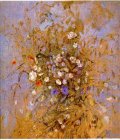 fig. 1
fig. 1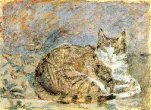 fig. 2
fig. 2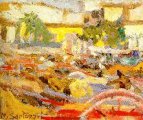 fig. 3
fig. 3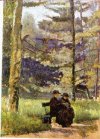 fig. 4
fig. 4 fig. 5
fig. 5 fig. 6
fig. 6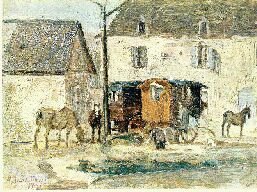 fig. 7
fig. 7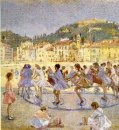 fig. 8
fig. 8